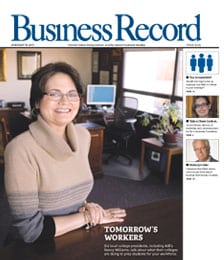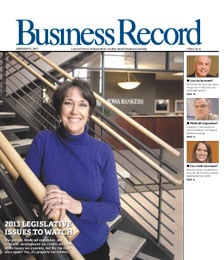Technology benefits hearing-impaired viewers

Closed captioning industry on the rise following federal mandate
Robyn Mengwasser likens her work as a stenocaptioner, someone who transcribes words spoken during live television broadcasts for the hearing impaired to read, to playing the piano. But it is the speed and accuracy she attains on her 23-key stenographer’s machine that captivates viewers.
“You’ve practiced the chords and the words, but it’s a song you’ve never played before,” Mengwasser said. “Some of its Bach and some of its easy listening.”
Mengwasser, owner of Golden Rule Captioning, is one of a handful of independent contractors in her field in Iowa. A graduate of AIB College of Business’ court reporting program, she has been working with a variety of local, national and international broadcasts since 1994. From Des Moines City Council meetings, to The Weather Channel nationwide, to Canadian newscasts, Mengwasser, with the help of her stenographer’s machine, computer software, a modem, a telephone line and an encoder, communicates with the world from her Des Moines home. In addition to TV shows, Mengwasser provides captioning for the hearing impaired in educational and corporate settings.
“It’s rewarding work,” she said. “I enjoy the writing, the job flexibility and doing something to help someone. This is my niche.”
Others may also find their niche in an industry that is rapidly growing because of a federal mandate requiring all local broadcasts to be captioned by 2006. Currently there are approximately 400 stenocaptioners nationwide, but there will be a need for at last 3,000.
The National Court Reporters Association reported last summer that enrollment at NCRA-approved reporter training programs were up 3 percent after eight years of steady decline. Officials predict the demand for broadcast captioners is expected to triple by 2006.
Meanwhile, enrollment in real-time reporting courses during the last two years at AIB has surpassed the national average. In 2002, 121 students were enrolled in real-time classwork at AIB, nearly double the total of 67 students enrolled in 2001. The school is the only one of its kind in a six-state area that offers captioning education.
Joan Bindel, vice president of admissions at AIB, said the school received a federal appropriation last year to be used for marketing the school’s stenocaptioning program. “The government knows there will be a need in the years ahead and to help meet the shortage they are helping us get the word out,” she said. “I think the field will change a lot in the next three years.”
Salaried positions for stenocaptioners can range from $45,000 to $75,000, and independent contractors can earn from $36,000 to $72,000, depending on the number of on-air hours. Computer access real-time reporters can earn between $35,000 and $65,000 per year.
Bindel said captioning is an evolving profession and the technology its practitioners use associated with captioning is rapidly advancing. She said AIB trains its students to exceed national recommendations for stenographers so they are better positioned to find work in market that will become increasingly competitive.
“The point is to get the message to the public as quickly and as accurately as possible,” Bindel said. “It’s crucial.”
With approximately 30 million viewers worldwide identified with hearing problems, Mengwasser said demand outpaces supply in her field.
“There are millions of people who benefit from this,” she said. “There used to be barriers for people with hearing loss, but thanks to computer technology, we are able to relay a message of equality.”
SIDEBAR: Ever wonder how closed captions that appear onscreen when you change the settings on your TV set get there? Broadcast captioners, also called stenocaptioners, use court reporter skills on a stenotype machine to provide captions of live television programs for deaf and hearing-impaired viewers through real-time technology that produces text in less than a second after it is spoken. These stenocaptioners work for local television stations and national networks captioning news, emergency broadcasts, sports and other programming, but the need for their services is about increase dramatically thanks to legislation. The federal Telecommunications Act of 1996 includes specific mandates for closed captioning of television programs around the country with phase-in dates of 2004 and 2006. In the next three years, the field of live captioning, which currently suffers from a severe shortage of qualified people, will experience a boom as the number of real-time captioners needed to cover news broadcasts around the country 24 hours a day will increase enormously.







